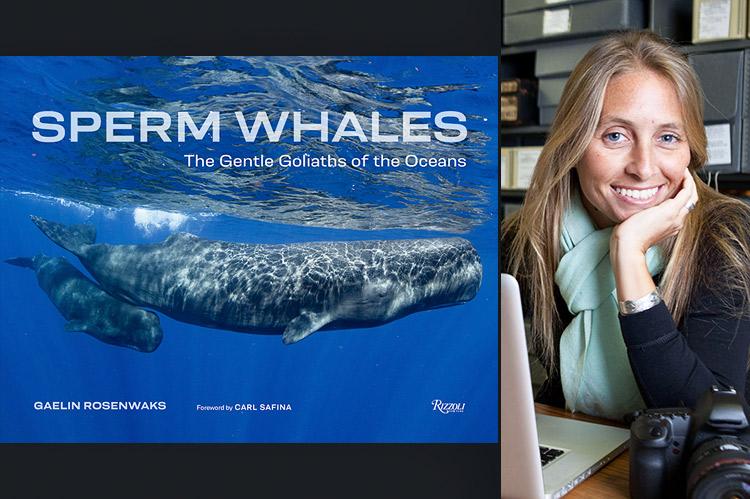
"Sperm Whales: The Gentle Goliaths of the Ocean," a new book of 160 underwater photographs by Gaelin Rosenwaks with a foreword by Carl Safina, lands somewhere in the cavernous realm of literary potential between "coffee-table book" and "scientific thesis."
The whale of a tome is a first for Ms. Rosenwaks, a scientist, explorer, and storyteller who lives in Montauk, and who founded the company Global Ocean Exploration to bring "cutting-edge expedition science to the public through photography, writing, and film." Her documentary, "Finding Physty" (due out sometime in 2023), was inspired by the famous sperm whale that has captivated Ms. Rosenwaks since she was a toddler, and expands on it by exploring her relationship with her mother, Stacy, who first took her to see that sperm whale, and who often accompanies her on her expeditions.
The sperm whale, of course, is the antihero of "Moby-Dick" and of the tale of Jonah from the Bible, so it's fitting that Ms. Rosenwaks tells a captivating story in her introduction -- though this is not fiction or fable. She reminds us about Physty, the juvenile male sperm whale who in 1981 fell ill and stranded himself in the waters off Long Island, and who was nursed back to health by marine scientists over the course of nine days as thousands of people looked on from the boat basin of Fire Island's Robert Moses State Park.
There's some overlap between the book and the forthcoming film, but, Ms. Rosenwaks explained, "The book really sort of nerds out on sperm whales and the remarkable relationships of these female sperm whales as a family. The film leans a little more into the human story -- about my mom and me. They're similar, but different."
During her filmmaking journey, she didn't set out specifically to publish a book, although it had been a goal of hers at some point. Rizzoli, the publisher, "contacted me when they heard about the project and they said, 'Would you like to do a book?' I said yes knowing that we would need to go back to Dominica to shoot more, because I was primarily shooting for the documentary."

Through Ms. Rosenwaks's photographs, the reader experiences the intersection of science and art.
"Everything in nature is art," she said. "What we try to do when we create images is bring that artistic perspective to the images. Different people can be in the same moment with the whale, but they're going to create a different image. In that way, it becomes art. And the movement of nature is so artistic . . . but also as a scientist, my perspective going into work is different from the work of an artist, because even though I'm making art, I'm trying to tell these moments of scientific discovery through these images."
She and her colleagues draft a shot list before they drop into the depths with their cameras, but in Ms. Rosenwaks's experience, "the animal pretty much dictates all of the images." (The weather influences them, too, she noted, with rough conditions or poor water quality as examples.)
"You go into it hoping that you'll see these moments," she said. "But you have to be ready to not miss those moments. . . . They completely decide what they're going to show you and you hope they show you something beautiful, and they always do, but the behavioral moments sort of write the script."
Ms. Rosenwaks emerged from her dives with tens of thousands of stills, making the process of selecting them for the book challenging. (One thing that she's proud of is that she "won the battle" over including photos of pooping whales -- "I thought it was a very important scientific thing to talk about that," she said.)
"There are certainly a lot more images that are on the cutting-room floor," she said. "Hopefully I'll use them for something else. It's just the way it is. You choose your best images to tell the story. That's what makes the editing process difficult but also exciting because it's always better to have more than less."
The goal of the book is twofold: convey a beautiful narrative in the story of matriarchal families of sperm whales -- which are nature's largest predators -- and document the environmental crisis that the world's oceans, and the creatures who live in them, are facing. She also wants people to fall in love with the whales, just as she has, and to take a journey "as opposed to just looking at photographs."
"It's certainly to increase awareness," Ms. Rosenwaks said. "Everything I do is always going to be around the ocean and science. [The book] has the beautiful images, but it also has the science, and it's something probably most people have never seen before."
That Mr. Safina agreed to write the foreword was huge for her. They have a friendly professional relationship. "I was super honored when he said yes, honestly. He had spent time with Physty in Dominica for his book 'Beyond Words,' so he was a good fit."
"In myth, real life, and fiction," Mr. Safina writes, "this is the whale that looms largest in our psyches. That almost-never-glimpsed being, so frequently framed as the perpetrator of our own rage, we now seek to meet at closest range."
If readers walk away from the book with even a fraction of the appreciation she feels for the beautiful sperm whales, Ms. Rosenwaks will have accomplished her goals.
"I don't think there's been a moment in the water with the whales that my mind is not completely blown by how magnificent they are," she said.




